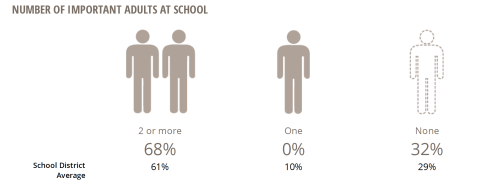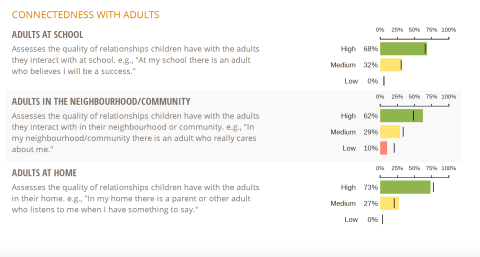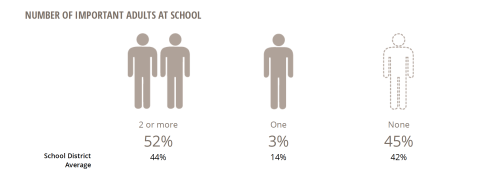Middle Years Development Instrument
One vital part of feeling connected to our community is by feeling connected with the people within it. In January 2019, our grade 4 and 7 students participated in the Middle Years Development Instrument, an online survey whereby students answer a number of questions related to their Social and Emotional Development, Physical Health and Well-Being, Connectedness, Use of After-School Time and School Experiences. This is created and run by Researchers from the Human Early Learning Partnership. *(More information directly from the MDI website is below).
One of the key pieces of information is how connected our students feel towards adults at school, at home, and in the community. The results for Kingswood, based upon the January data, showed:
Grade 4 Students:
-68 % of students reported connectedness with adults at school
-62 % of students reported connectedness with adults in the neighbourhood/community
-73 % of students reported connectedness with adults at home
-68 % felt that they had two or more important adults at school
Grade 7 Students:
-62 % of students reported connectedness with adults at school
-44 % of students reported connectedness with adults in the neighbourhood/community
-82 % of students reported connectedness with adults at home
-52 % felt that they had two or more important adults at school
We will compare this data with our scanning of our intermediate students in the late spring to see if there are improvements in these percentages.
INTRODUCTION
WHY THE MIDDLE YEARS MATTER
Experiences in the middle years, ages 6 to 12, have critical and long lasting effects. They are powerful predictors of adolescent adjustment and future success. During this time, children are experiencing significant cognitive, social and emotional changes that establish their lifelong identity and set the stage for adolescence and adulthood. The overall health and well-being of children in their middle years affects their ability to concentrate and learn, develop and maintain friendships, and make thoughtful decisions. Early adolescent children have an increased awareness of themselves and others. During middle childhood they are developing ideas about how they may or may not “fit in” to their social and academic environments. These ideas have the power to either promote health and academic achievement or lead to negative outcomes such as depression and anxiety in adolescence and adulthood. Although middle childhood is a time of risk, it is also a time of opportunity. There is mounting evidence to suggest that positive relationships with adults and peers during this critical time act to increase a child’s resiliency and success.
ABOUT THE MIDDLE YEARS DEVELOPMENT INSTRUMENT
The Middle Years Development Instrument (MDI) is a self-report questionnaire that asks children in Grade 4 and Grade 7 about their thoughts, feelings and experiences in school and in the community. The MDI is not an assessment for individual children. Instead, it is a unique and comprehensive population-based measure that helps us gain a deeper understanding of children’s health and well-being during middle childhood. Researchers at the Human Early Learning Partnership (HELP) are using results from the MDI to understand the factors that promote children’s social-emotional health and well-being. In addition, the MDI is being used across sectors and to support collaboration and inform policy and practice.
The MDI uses a strengths-based approach to assess five areas of development that are strongly linked to children’s well-being, health and academic achievement. It focuses on highlighting the protective factors and assets that are known to support and optimize development in middle childhood. These areas are: Social and Emotional Development, Physical Health and Well-Being, Connectedness, Use of After-School Time and School Experiences. Each of these dimensions is made up of several measures and each measure is made up of one or more questions.



